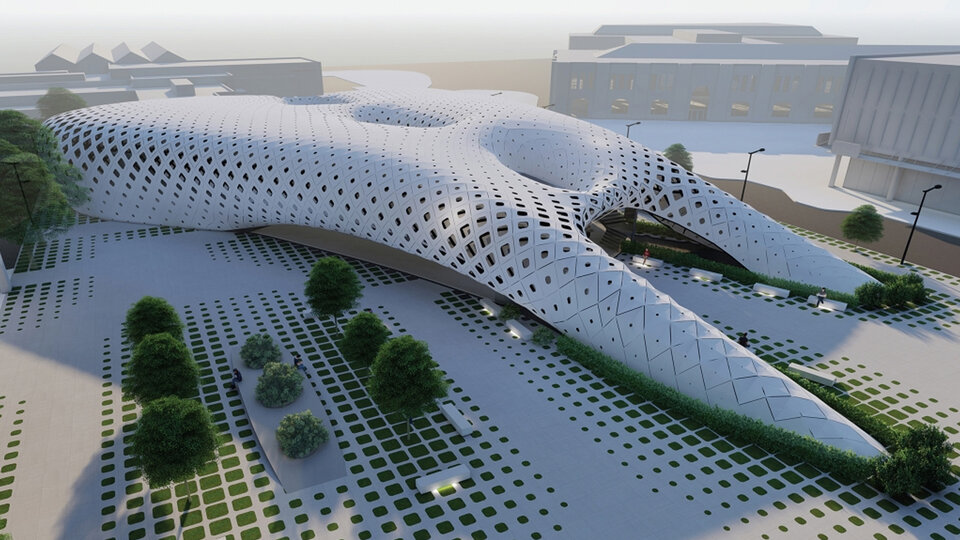Computation
Computational architecture is revolutionizing the way buildings are designed, analyzed, and constructed. For Master of Architecture students, learning computational design techniques is crucial for staying competitive in an evolving industry where digital tools enhance creativity, efficiency, and sustainability.
Preparing You for the Future
Computational architecture is revolutionizing the way buildings are designed, analyzed, and constructed. For Master of Architecture students, learning computational design techniques is crucial for staying competitive in an evolving industry where digital tools enhance creativity, efficiency, and sustainability.
Skills Gained
- Parametric Design & Algorithmic Thinking – Students learn how to use software like Grasshopper, Rhino, and Python to generate complex, adaptable forms based on data-driven inputs.
- Automation & Optimization – Computational design allows for rapid iterations, testing multiple design options and optimizing for structural integrity, material efficiency, and environmental performance.
- Digital Fabrication & Robotics – Understanding CNC machining, 3D printing, and robotic construction prepares students to bridge the gap between digital design and real-world production.
- Data-Driven Design & Analysis – Computational tools enable architects to integrate climate data, user behavior, and structural performance simulations into their design process.
- Interdisciplinary Collaboration – Computational architecture fosters collaboration with engineers, programmers, and material scientists, expanding the architect’s role beyond traditional design boundaries.
- Advanced Visualization & Simulation – Students gain skills in virtual reality (VR), augmented reality (AR), and AI-driven rendering to communicate design ideas more effectively.
Competitive Edge
- Enhances Design Innovation – Computational tools allow architects to explore complex geometries and adaptive structures that would be difficult or impossible to design manually.
- Improves Workflow Efficiency – Automation reduces repetitive tasks, streamlining design development and documentation processes.
- Increases Employability – Firms increasingly seek architects with computational skills, especially in high-tech design fields, digital fabrication, and smart building technologies.
- Prepares for Future Technologies – As AI, machine learning, and generative design continue to shape the industry, computational skills ensure architects remain at the forefront of innovation.
- Enables Customization & Mass Production – Computation allows for mass customization in construction, where unique, site-specific designs can be efficiently manufactured at scale.
Elevate Your Potential
Computational design is not just about aesthetics—it’s about expanding the possibilities of architecture. By integrating computation into the design process, architects can create more responsive, sustainable, and efficient buildings. Computational tools empower designers to solve complex problems, simulate real-world conditions, and optimize designs in ways that traditional methods cannot. This shift moves architecture beyond intuition-based decision-making into a data-driven, performance-oriented discipline.
Beyond Education: The Broader Impact
Computational architecture also has significant implications for the industry and society:
- Sustainability & Performance-Driven Design – Computational simulations enable architects to minimize energy use, reduce material waste, and create buildings that respond intelligently to their environment.
- Affordable & Accessible Design Solutions – Digital fabrication methods can lower construction costs, making innovative design more accessible to communities in need.
- Integration with Smart Cities & AI – Computational design plays a crucial role in the development of smart buildings and cities, where architecture interacts seamlessly with technology, sensors, and automation.
- Reshaping Construction Techniques – Robotics and parametric modeling are transforming how buildings are constructed, leading to more efficient, precise, and creative fabrication methods.
Why It Matters
Computational architecture is redefining the role of architects, providing them with the tools to design smarter, build better, and push creative boundaries. By mastering computational methods, architecture students position themselves at the cutting edge of the field, equipped with the knowledge and skills needed to shape the future of the built environment.
How We Teach Computation
Our computational offerings engage students in three ways:
1. through a course offering for academic credit such as Parametric Modeling for Design ;
2. through ad hoc independent study contracts for academic credit; and
3. through research opportunities (See below).
AI+EDL is a multi-disciplinary research lab focused on the development of next generation technologies to improve the built environment. We are always seeking members who have a passion to improve the world and are oriented towards design and technology.
UNL undergraduates
Undergraduate students can get involved with AI+EDL through the UCARE program at the UNL which provides a stipend to work on advanced research. Interested students should contact Professor Newton directly to discuss possible research projects. Deadlines for the proposals are: December 3 - January 21: Summer Application Period; February 4 - March 11: Academic Year Application Period
UNL graduate Students
Graduate students in Architecture can get involved with AI+EDL through their thesis research and as research assistants. Graduate students outside the College of Architecture are also encouraged to get involved through research assistant positions. Students with Computer Science and Engineering backgrounds fit particularly well with the research. Please contact us if you are interested in joining our team.
